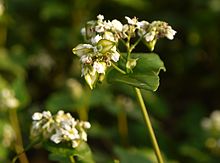Fagopyrum esculentum
| Buckwheat Fagopyrum esculentum |
|
|---|---|
 |
|
| Scientific classification | |
| Kingdom: | Plantae |
| (unranked): | Angiosperms |
| (unranked): | Eudicots |
| (unranked): | Core eudicots |
| Order: | Caryophyllales |
| Family: | Polygonaceae |
| Genus: | Fagopyrum |
| Species: | F. esculentum |
| Binomial name | |
|
Fagopyrum esculentum Moench |
|
| Synonyms | |
|
|
| Nutritional value per 100 g (3.5 oz) | |
|---|---|
| Energy | 1,435 kJ (343 kcal) |
|
71.5 g
|
|
| Dietary fiber | 10 g |
|
3.4 g
|
|
| Saturated | 0.741 g |
| Monounsaturated | 1.04 g |
| Polyunsaturated | 1.039 g
0.078 g
0.961 g
|
|
13.25 g
|
|
| Vitamins | |
| Thiamine (B1) |
(9%)
0.101 mg |
| Riboflavin (B2) |
(35%)
0.425 mg |
| Niacin (B3) |
(47%)
7.02 mg |
| Pantothenic acid (B5) |
(25%)
1.233 mg |
| Vitamin B6 |
(16%)
0.21 mg |
| Folate (B9) |
(8%)
30 μg |
| Vitamin C |
(0%)
0 mg |
| Minerals | |
| Calcium |
(2%)
18 mg |
| Iron |
(17%)
2.2 mg |
| Magnesium |
(65%)
231 mg |
| Manganese |
(62%)
1.3 mg |
| Phosphorus |
(50%)
347 mg |
| Potassium |
(10%)
460 mg |
| Sodium |
(0%)
1 mg |
| Zinc |
(25%)
2.4 mg |
| Other constituents | |
| Copper | 1.1 mg |
| Selenium | 8.3 µg |
|
|
|
|
|
| Percentages are roughly approximated using US recommendations for adults. | |
Buckwheat (Fagopyrum esculentum) is a plant cultivated for its grain-like seeds and as a cover crop. To distinguish it from a related species, Fagopyrum tataricum, it is also known as Japanese buckwheat and silverhull buckwheat.
Despite the name, buckwheat is not related to wheat, as it is not a grass. Instead, buckwheat is related to sorrel, knotweed, and rhubarb. Because its seeds are eaten and rich in complex carbohydrates, it is referred to as a pseudocereal. The cultivation of buckwheat grain declined sharply in the 20th century with the adoption of nitrogen fertilizer that increased the productivity of other staples.
The name 'buckwheat' or 'beech wheat' comes from its triangular seeds, which resemble the much larger seeds of the beech nut from the beech tree, and the fact that it is used like wheat. The word may be a translation of Middle Dutch boecweite: boec (Modern Dutch beuk), "beech" (see PIE *bhago-) and weite (Mod. Dut. weit), wheat, or may be a native formation on the same model as the Dutch word.
The wild ancestor of common buckwheat is F. esculentum ssp.ancestrale. F. homotropicum is interfertile with F. esculentum and the wild forms have a common distribution, in Yunnan, a southwestern province of China. The wild ancestor of tartary buckwheat is F. tataricum ssp. potanini.
Common buckwheat was domesticated and first cultivated in inland Southeast Asia, possibly around 6000 BCE, and from there spread to Central Asia and Tibet, and then to the Middle East and Europe. Domestication most likely took place in the western Yunnan region of China. Buckwheat is documented in Europe in Finland by at least 5300 BCE as a first sign of agriculture, and in the Balkans by circa 4000 BCE in the Middle Neolithic. Russian-speakers call buckwheat (grechka) meaning "of Greece", due to its introduction in the seventh century by the Byzantine Greeks; the same is the case in Ukrainian.
...
Wikipedia
